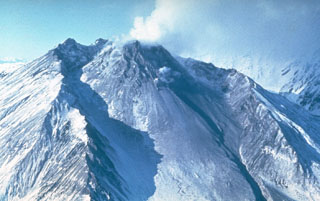Report on Bezymianny (Russia) — May 1992
Bulletin of the Global Volcanism Network, vol. 17, no. 5 (May 1992)
Managing Editor: Lindsay McClelland.
Bezymianny (Russia) Gas emission from center of dome
Please cite this report as:
Global Volcanism Program, 1992. Report on Bezymianny (Russia) (McClelland, L., ed.). Bulletin of the Global Volcanism Network, 17:5. Smithsonian Institution. https://doi.org/10.5479/si.GVP.BGVN199205-300250
Bezymianny
Russia
55.972°N, 160.595°E; summit elev. 2882 m
All times are local (unless otherwise noted)
Gas emission from the center of Novy Dome produced a white-and-brown plume that covered the dome complex, especially its NE side, during an 18 May visit. No evidence of recent collapse was visible.
Geological Summary. The modern Bezymianny, much smaller than its massive neighbors Kamen and Kliuchevskoi on the Kamchatka Peninsula, was formed about 4,700 years ago over a late-Pleistocene lava-dome complex and an edifice built about 11,000-7,000 years ago. Three periods of intensified activity have occurred during the past 3,000 years. The latest period, which was preceded by a 1,000-year quiescence, began with the dramatic 1955-56 eruption. This eruption, similar to that of St. Helens in 1980, produced a large open crater that was formed by collapse of the summit and an associated lateral blast. Subsequent episodic but ongoing lava-dome growth, accompanied by intermittent explosive activity and pyroclastic flows, has largely filled the 1956 crater.
Information Contacts: H. Gaudru, SVE, Switzerland; G. de St. Cyr, T. de St. Cyr, and I. de St. Cyr, A.V. Lyon, France; T. Vaudelin, Genève, Switzerland.

